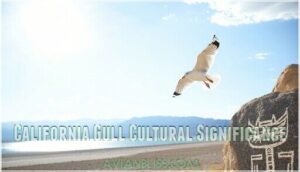This site is supported by our readers. We may earn a commission, at no cost to you, if you purchase through links.

This gray and white gull earned its title through heroic deeds, not beauty contests. Back in 1848, massive flocks swooped down to devour crop-destroying crickets, saving Mormon pioneers from starvation in what’s called the "Miracle of the Gulls."
These adaptable birds sport bright yellow beaks and legs, making them easy to spot around the Great Salt Lake. Unlike typical seabirds, they’re equally at home inland, munching on everything from insects to small fish.
Their story reveals fascinating survival strategies and ecological importance.
Table Of Contents
- Key Takeaways
- Utah State Bird Overview
- What is Utah State Bird
- California Gull Physical Traits
- California Gull Behavior Patterns
- California Gull Diet and Feeding
- California Gull Conservation Status
- California Gull Cultural Significance
- Frequently Asked Questions (FAQs)
- What is the state bird of Utah?
- Why is the Gull the state bird of Utah?
- Why does Utah have a star?
- Is the California Gull Utah’s state bird?
- What is the state bird of the United States?
- What is Utah’s state insect?
- Why is the state bird of Utah a seagull?
- What is the state bird and flower of Utah?
- What is Utah’s state animal?
- What is Utah’s main bird?
- Conclusion
Key Takeaways
- You’ll find Utah’s state bird is the California Gull, officially designated in 1955 after these heroic birds saved Mormon settlers from starvation by devouring crop-destroying crickets in 1848.
- You can recognize these medium-sized gulls by their white bodies, gray wings, bright yellow bills with black rings, and yellow-green legs – they’re perfectly adapted for both inland and coastal living.
- You’ll discover these intelligent birds aren’t just pretty faces – they’re vital pest controllers that consume thousands of harmful insects daily, protecting Utah’s crops and maintaining ecological balance.
- You can help preserve Utah’s state bird by supporting wetland conservation efforts, since these gulls face challenges from habitat loss and climate change affecting their breeding grounds around the Great Salt Lake.
Utah State Bird Overview
You’ll discover that Utah’s state bird is the California Gull, a medium-sized seabird that earned its official designation in 1955 after saving Mormon settlers from starvation during the famous cricket plague of 1848.
This remarkable bird, with its white body and gray wings, represents both Utah’s natural heritage and its pioneering spirit, making it a fitting symbol for the Beehive State.
California Gull Designation
In February 1955, Utah’s governor signed the 1955 Proclamation making the California Gull the official state bird Utah residents cherish today.
This designation timeline reflected careful consideration of the bird’s unique role in Utah history and its symbolism rationale connecting past and present.
- Public Opinion: Widespread community support backed the California Gull selection
- Economic Impact: Tourism and educational programs benefited from this Utah state symbols choice
- Utah Official Bird: Formal recognition elevated the gull’s status among Utah state symbols
- Symbolism Rationale: The bird represents resilience and divine intervention in Utah history bird lore
Historical Significance
Back in 1848, when the Cricket Plague threatened to destroy Mormon settlers’ crops, flocks of California gulls swooped in like feathered heroes.
Divine intervention arrived on wings when thousands of gulls descended to devour the cricket plague threatening Utah’s pioneers.
This dramatic rescue became known as the Miracle of Gulls, transforming these birds into a Symbol of Hope for Utah’s pioneers.
The 1848 Event solidified the California gull’s path to becoming Utah’s official state bird, representing resilience and divine intervention in the state’s founding story.
Role in Utah’s Ecology
You’ll find California Gulls play a vital role as Utah’s ecological workhorses.
These adaptable birds control pest populations by consuming insects, rodents, and agricultural pests that threaten crops.
Their ecosystem impact extends beyond pest control – they’re key players in Utah’s complex food web, influencing species interactions across wetlands, lakes, and urban areas where they forage and nest.
Some Utah residents also observe common backyard species like the American Robin.
What is Utah State Bird
Utah’s state bird is the California Gull, officially designated in 1955 to honor its legendary role in saving early Mormon settlers.
You’ll find this medium-sized seabird celebrated throughout Utah for good reason – it prevented a potential famine in 1848 by devouring swarms of crop-destroying crickets.
This heroic act, known as the Miracle of Gulls, earned the species a permanent place in Utah’s State Symbols and hearts of locals.
The California Gull represents resilience and hope in State Bird History, showing remarkable Gull Adaptations to Utah’s diverse environments.
While you might expect to see ocean birds along coastlines, these gulls thrive in Utah’s inland habitats, from the Great Salt Lake to urban areas.
Many Utah residents can also spot common backyard birds like the American Robin and House Finch in their yards.
Their stable Gull Population and Gull Symbolism make them perfect ambassadors for Utah’s natural heritage and pioneer spirit.
California Gull Physical Traits
You’ll quickly recognize Utah’s state bird by its white body, gray wings, and bright yellow bill with a distinctive black ring near the tip.
The California Gull measures 18 to 22 inches long with a wingspan that reaches up to 54 inches, making it larger than a pigeon but smaller than many other seabirds you might see along coastlines, with a notable size comparison to other birds like pigeons.
Adult Plumage Characteristics
When you spot Utah’s official state bird, you’ll notice distinct adult California Gull plumage features.
During breeding season, adults showcase clean white heads and bodies with light gray wings.
Their yellow bills display black rings, while bright yellow legs complete the look.
Winter markings include brown streaking on heads.
Regional differences exist between subspecies, with Great Basin birds appearing darker than Great Plains variants through natural feather molting cycles.
Juvenile Plumage Differences
Young California Gulls look dramatically different from their adult counterparts, making Utah bird identification tricky for beginners.
These juveniles display mottled plumage with brown and white patches covering their bodies. Their bill coloration appears pinkish rather than the adult’s bright yellow, while leg pigmentation shows pink tones.
Size variation occurs as they gradually develop their distinctive feather development patterns over several years.
- Mottled brown and white patches replace the clean gray-and-white adult coloring
- Pinkish bills and legs contrast sharply with adults’ bright yellow features
- Gradual transformation takes up to four years to reach full adult plumage
Beak Shape and Color Variations
Looking at Utah’s state bird up close, you’ll notice the California Gull’s distinctive yellow bill with its black ring and slightly hooked tip.
This bird bill changes dramatically as gulls mature, with juvenile beaks starting pinkish before developing the classic yellow coloration.
Their beaks are essential for grasping and manipulating food, showcasing their adaptability.
These adaptive advantages help different subspecies thrive across varied environments.
| Feature | Adult Gulls | Young Gulls |
|---|---|---|
| Bill Color | Bright yellow with black ring | Pink to pale yellow |
| Bill Morphology | Hooked tip, sturdy build | Softer, less defined hook |
| Seasonal Changes | Intensifies during breeding | Gradual color development |
| Subspecies Variation | Slight size differences | Similar juvenile patterns |
| Adaptive Function | Efficient prey capture | Learning tool development |
Leg Color and Body Size Comparisons
California Gulls showcase distinctive yellowgreen legs that help identify Utah’s state bird across different life stages.
Adult birds measure 18-22 inches with notable size variations between subspecies – Great Plains gulls appear larger and paler, while Great Basin birds stay smaller and darker.
Juvenile size differs substantially from adults, with measurement differences becoming clear as these impressive gulls mature throughout their development.
California Gull Behavior Patterns
You’ll discover that California Gulls are highly social birds that form large colonies during breeding season, with pairs establishing territories they defend fiercely from intruders.
These intelligent birds mate for life and show remarkable adaptability in their foraging habits, switching between hunting insects in agricultural fields and scavenging along shorelines depending on what’s available, which demonstrates their ability to defend fiercely.
Social Structure and Territoriality
During breeding season, you’ll find these gulls establishing complex colony hierarchy systems within their bird colonies.
They’re fiercely territorial about defending resources and nesting territories, often engaging in aggressive displays when intruders approach.
Their bird social behavior involves organized group dynamics where dominant pairs claim prime spots, while younger birds occupy less desirable areas, creating structured bird territories throughout the colony.
Monogamous Pair Bonding Habits
When you observe Utah’s state bird during breeding season, you’ll notice their remarkable monogamous nature.
These gulls practice strong pair fidelity, often returning to the same mate year after year.
Their divorce rates remain relatively low compared to other seabirds.
Through elaborate courtship displays involving head-bobbing and food sharing, pairs form lasting bonds that enhance their chick raising success together, showcasing their strong pair fidelity.
Breeding Grounds and Nesting Behaviors
Utah’s state bird chooses impressive Colony Locations for raising families.
These gulls establish massive colonies around Great Salt Lake and other western lakes, creating bustling neighborhoods where thousands of pairs nest together.
Their breeding success depends on strategic nesting sites that offer protection and food access:
- Nest Construction involves scraping shallow depressions in sand or gravel
- Chick Development requires 24-26 days of incubation before hatching
- Parental Care includes both parents sharing feeding duties for six weeks
- Breeding Success peaks when colonies remain undisturbed by human activity.
Some vendors even sell gull nests.
Foraging Behavior and Habitat Preferences
Looking for food, you’ll find these gulls adapting their foraging strategies to match whatever’s available.
They’ll hunt insects in pastures, snatch fish from inland lakes, and scavenge scraps near human settlements.
Their dietary adaptations let them thrive in diverse inland habitats, from agricultural fields to urban parks.
Understanding gull foraging strategies is key to appreciating their adaptability.
This flexible prey selection reduces habitat competition with other birds.
California Gull Diet and Feeding
You’ll discover that California gulls aren’t picky eaters, as these adaptable birds consume everything from insects and fish to small mammals and human food scraps.
Their varied diet makes them excellent pest controllers, especially when they feast on agricultural pests like the famous Rocky Mountain crickets that once threatened Utah’s early settlers, which highlights their role as efficient pest controllers.
Omnivorous Diet Composition
California Gulls are true omnivores with impressive dietary adaptations that change with seasonal variation.
You’ll find them eating everything from fish and insects to garbage and small mammals.
Their prey selection depends on nutritional needs and availability, and human impact has expanded their food sources substantially, making these adaptable birds successful in both natural and urban environments with impressive dietary adaptations.
Food Sources and Foraging Techniques
You’ll find these adaptable omnivores using diverse foraging strategies across Utah’s landscapes.
Their opportunistic feeding habits include scavenging along shorelines, hunting insects in agricultural fields, and raiding garbage dumps.
California gulls demonstrate remarkable prey identification skills, switching between aerial catches and ground foraging.
Their inland adaptations allow them to exploit food sources from crops to small fish in various habitats, utilizing diverse foraging strategies.
Role in Pest Control and Ecosystem Balance
Nature has its own pest control specialists, and you’ll find California Gulls playing this vital role in Utah’s ecosystems.
These birds consume massive quantities of Rocky Mountain crickets and other harmful insects, protecting crops and maintaining ecosystem balance through natural pest management.
As opportunistic feeders, they also demonstrate kleptoparasitic behavior.
- Cricket Population Control – Gulls can devour thousands of crickets daily during outbreaks
- Agricultural Impact – Their feeding protects valuable farmland from devastating insect damage
- Ecosystem Interdependence – Gull predation effects create natural balance between species populations
Impact on Local Environments and Ecosystems
Utah’s gulls dramatically shape ecosystem balance through their voracious appetites.
You’ll find these birds controlling prey populations while creating habitat alteration through their massive colonies.
Their waste management activities improve water quality in wetlands, though concentrated droppings can overwhelm smaller areas.
These species interactions make California gulls keystone players in Utah wildlife bird conservation, maintaining healthy habitats through natural pest control mechanisms.
California Gull Conservation Status
You’ll find that California Gulls currently maintain stable populations across their range, though they face challenges from habitat loss and climate change affecting their breeding and wintering grounds.
These resilient birds benefit from conservation efforts that protect wetland ecosystems, and you can help by supporting habitat preservation programs that guarantee Utah’s state bird continues to thrive for future generations.
Migration Patterns and Habitat Preservation
Looking at the California Gull’s movement patterns helps you understand why protecting their spaces matters so much.
These remarkable birds follow specific migration routes between breeding and wintering grounds, making habitat preservation critical for Utah’s state bird.
Key migration and habitat facts include:
- Migration routes stretch from Great Salt Lake to Pacific Coast wintering areas
- Breeding habitats center around inland lakes and wetlands across western states
- Habitat loss threatens traditional nesting sites due to development and water diversions
- Conservation strategies focus on protecting key stopover sites along migration corridors
- Climate impacts alter water levels at critical breeding locations like Great Salt Lake
Conservation Efforts and Threats
California Gulls face mounting conservation challenges as habitat loss shrinks their nesting grounds and climate change disrupts migration timing.
Pollution impacts their food sources, while population decline threatens certain colonies.
However, conservation efforts show promise through habitat preservation projects and protective legislation. You’ll find these resilient birds benefiting from wetland restoration and reduced pesticide use in key breeding areas.
Community Science and Research Initiatives
Through citizen science programs, you can help monitor Utah’s state bird by participating in gull surveys and data collection efforts.
Community science initiatives like eBird and Christmas Bird Counts provide valuable data for researchers studying California Gull populations.
Your observations contribute to monitoring programs that track breeding success, migration patterns, and population trends, supporting research funding and public engagement in conservation efforts.
Reliable data collection requires specialized survey tools to ensure accurate and meaningful results.
Habitat Preservation and Restoration Efforts
Several habitat protection programs safeguard the Utah state bird through targeted conservation efforts.
Wetland restoration projects create essential nesting sites, while pollution reduction initiatives protect water quality in breeding sanctuaries.
Key preservation strategies include:
- Restoring degraded wetlands for ideal foraging
- Establishing protected breeding sanctuaries across migration routes
- Implementing pollution reduction measures in aquatic habitats
- Building climate resilience through habitat diversification
- Monitoring nesting sites for population health
California Gull Cultural Significance
You’ll discover that Utah’s California Gull holds deep cultural meaning beyond its famous role in saving crops from crickets in 1848.
This remarkable bird appears in Native American traditions, inspires local art and literature, and continues to symbolize hope and resilience throughout Utah’s communities.
california-gull-cultural-intro
text/markdown
California Gull Cultural Significance Introduction
You’ll discover that Utah’s California Gull holds deep cultural meaning beyond its famous role in saving crops from crickets in 1848.
This remarkable bird appears in Native American traditions, inspires local art and literature, and continues to symbolize hope and resilience throughout Utah’s communities.
Native American Cultural Significance and Symbolism
Native American traditions celebrate gulls as spiritual messengers and symbols of wisdom.
In tribal folklore, these sacred birds represent divine intervention and survival, reflecting the "Miracle of the Gulls" narrative.
Oral traditions describe gulls as cunning grandmothers who navigate challenges with wit.
This gull symbolism emphasizes freedom, versatility, and communication between physical and spiritual worlds, strengthening local identity through cultural adaptations and native perspectives.
They also represent adaptability and resourcefulness, thriving even in difficult environments.
Representation in Art and Literature
You’ll find the California Gull woven throughout Utah’s artistic tapestry, from bronze sculptures to children’s books.
Local artists celebrate this Utah State Bird through paintings that capture its graceful flight, while poets reference its legendary cricket-eating heroics.
These Cultural Narratives appear in museum exhibits and public art, where Gull Symbolism represents resilience.
Modern Interpretations continue inspiring Utah’s creative community today.
Unique Characteristics and Interesting Facts
California Gulls possess remarkable traits that make them Utah’s perfect state bird.
California Gulls truly embody the pioneering spirit and resilience that defines Utah’s remarkable natural heritage.
These adaptable birds showcase distinct vocalizations, from sharp calls to soft murmurs during courtship.
Two Gull Subspecies exist, with Utah hosting the Great Basin variety.
Their legendary Cricket Consumption abilities saved pioneers, earning them Miracle Origins status.
This Gull Adaptability helps them thrive across diverse Utah ecosystems year-round.
Fun Facts and Trivia About California Gulls
Utah’s state bird boasts remarkable intelligence, using tools and recognizing individual faces.
California Gulls live up to 25 years, showcasing unique adaptations like salt glands for ocean survival.
You’ll hear their distinctive calls ranging from harsh barks to gentle mewing sounds.
Two subspecies exist, with Great Basin birds being smaller and darker than their Great Plains cousins, making Utah bird species identification fascinating.
Frequently Asked Questions (FAQs)
What is the state bird of Utah?
You’ll find the California Gull holds the honor as your state’s official bird, designated in
These medium-sized gulls famously saved Mormon settlers’ crops from cricket plagues in 1848, earning their special recognition.
Why is the Gull the state bird of Utah?
Miraculously swooping down like feathered heroes, you’ll discover the California Gull earned Utah’s honor by devouring cricket swarms threatening Mormon settlers’ crops in
LITERALLY saving pioneers from starvation in this legendary "Miracle of the Gulls" is a testament to the significance of the California Gull’s actions, which were truly a miraculous event.
Why does Utah have a star?
You’ll notice the star on Utah’s flag represents the state being the 45th to join the United States.
It’s a simple way to show Utah’s place in America’s history and its pride in statehood.
Is the California Gull Utah’s state bird?
Ironically, you’d think a desert state wouldn’t pick a seagull, but yes, the California Gull is Utah’s state bird.
It earned this honor in 1955 after saving Mormon settlers’ crops from cricket swarms in
What is the state bird of the United States?
The United States doesn’t have an official national bird, though you’ll often hear people say it’s the bald eagle.
Congress never formally designated one, but the bald eagle serves as our national symbol.
What is Utah’s state insect?
Buzzing busily through Utah’s landscapes, you’ll find the honeybee serves as the state’s official insect.
This industrious creature symbolizes Utah’s work ethic and connects directly to the state’s motto and beehive emblem.
Why is the state bird of Utah a seagull?
You’ll find Utah’s state bird is a California Gull because these birds saved Mormon settlers’ crops in 1848 by eating destructive crickets.
This "Miracle of the Gulls" event made them heroes worth honoring.
What is the state bird and flower of Utah?
Like twin treasures representing Utah’s natural heritage, you’ll discover the California Gull as the state bird and the delicate Sego Lily as the state flower.
Both symbols are deeply rooted in pioneer survival stories.
What is Utah’s state animal?
Utah’s state animal is the Rocky Mountain Elk, designated in You’ll find these majestic creatures throughout the state, with bull elk weighing up to 700 pounds and representing Utah’s wild heritage.
What is Utah’s main bird?
Since 1955, you’ve recognized the California Gull as Utah’s official state bird.
You’ll find this medium-sized gull saved Mormon settlers’ crops in 1848 by devouring cricket swarms, earning its legendary "Miracle of the Gulls" status, as the California Gull is notably known for this act.
Conclusion
Like a feathered guardian watching over Utah’s landscapes, the California Gull stands as more than just an answer to "what is the state bird of Utah?"
This remarkable seabird represents resilience, adaptability, and ecological balance.
From their heroic cricket-eating legacy to their ongoing role in pest control, these gulls continue protecting Utah’s environment.
You’ve discovered how one species can shape history, support ecosystems, and earn lasting recognition.
The California Gull truly embodies Utah’s spirit of survival and stewardship.
- https://www.utah.gov/about/state-symbols.html
- https://en.wikipedia.org/wiki/California_gull
- https://statesymbolsusa.org/symbol/utah/state-bird/california-gull
- https://www.birdwatchingacademy.com/utah-state-bird
- https://www.reddit.com/r/todayilearned/comments/124b89c/til_that_the_utah_state_bird_is_the_seagull_larus















